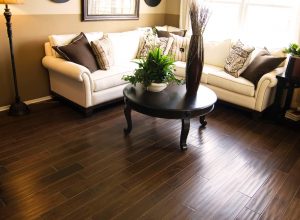 When restoring hardwood flooring, homeowners often have a difficult decision between hiring a pro restoration company and doing it yourself. Some homeowners initially gravitate towards the DIY way, which is cheaper than hiring a specialist restoration service. But when you think about the types of mistakes you could make on a hardwood floor restoration project, you may want to reconsider tackling the project on your own. While it is possible for a homeowner to learn some important pointers about restoring wood floors, the best advice comes from professionals.
When restoring hardwood flooring, homeowners often have a difficult decision between hiring a pro restoration company and doing it yourself. Some homeowners initially gravitate towards the DIY way, which is cheaper than hiring a specialist restoration service. But when you think about the types of mistakes you could make on a hardwood floor restoration project, you may want to reconsider tackling the project on your own. While it is possible for a homeowner to learn some important pointers about restoring wood floors, the best advice comes from professionals.
The most common mistake when doing floor restoration on your own is sanding incorrectly. Sanding is a vital part of the floor repair process, as it removes layers of old flooring and allows the newer, undamaged flooring to show through. However, there are many ways to sand correctly, and homeowners often make the same mistakes as they do with other DIY projects. For example, some people try to sand unevenly, using the wrong tool, or they sand too much, causing a bumpy finish. To avoid these problems, take the time to find out the proper sanding technique.
Another common mistake when refinishing wood floors is selecting the wrong wood filler. A wood floor restoration process should always start with an inspection of the wood. Only settle on the filler if it enhances the wood grain. For example, oak floor sanding should always start with an examination of the wood’s texture to ensure it is straight. It is always better to choose a filler that matches the wood grain, and not one that will hide or change the existing pattern.
Also, it is always best to work with the grain of the wood instead of trying to mask it. Most people don’t realize that sanding hardwood floor restoration is actually harder than refinishing using a floating finish. The reason is because a floating finish hides the grain while refinishing does not. In order to get a smooth finish, the wood must be thoroughly ground down using mineral spirits. This makes it easier for the finisher to use a rough buff and finish the floor at the same time.
The last type of mistake that is made during floor restoration is improper selection of the right finish. A wood floor refinisher may mask or cover up defects, but it never completes the job by providing a protective coating. Using a low-grade, epoxy coating is a mistake that can leave the wood damaged and dull over time. Therefore, any wood floor restoration should begin with a thorough cleaning and then finishing the refinishing with a high-quality, protective coating.
Floor refinishing is a great way to restore your home to its original beauty. However, you should always make sure that you’re following a process that provides the best result possible. Sanding, polishing, sealing, and a protective coat are necessary steps in this process. When these steps are followed correctly, you’ll find that your hardwood floors will look as great as they did the day you first installed them.